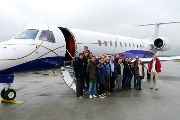
REFLECT - The REsearch FLight of EURADOS and CRREAT
29. 11. 2017
Research flight with unique cosmic radiation detectors was performed over the Czech Republic.
On November 29, 2017, the CRREAT team realized an international experiment focused on the influence of cosmic radiation onboard aircraft. Czech experts, along with colleagues from nine countries, compared – directly in flight – the methods and devices used to measure cosmic radiation. The results of experiment will contribute to the further development of the most accurate standardized dosimeter to be flown on board commercial aircraft and will provide valuable insight into further development of air transport safety.
The research flight is part of the research activities of the CRREAT project funded by the European Structural and Investment Funds under the Operational Program Research, Development and Education. It was attended by representatives of institutions from all over the world, in particular from EURADOS (European Radiation Dosimetry Group), some of them personally, others sent their devices only. The test focused on the characterization of the radiation field with various instruments onboard the aircraft during their common flight under steady conditions (one flight level and a small range of geographical coordinates). Several dozen different radiation detectors have been compared. They were based on the Embraer Legacy 600 aircraft operated by ABS Jets company, which succeeded in making this research flight and its fleet fulfilled the demanding requirements of the scientific experiment. “The number of devices and subscribers was now several times larger than the previous similar experiments in the world,” says Ondřej Ploc, research scientist at the DRD of NPI CAS and the Deputy Director of the CRREAT project. The Embraer Legacy 600, together with 250 kg of equipment and its eight-member scientific staff, led from Vaclav Havel Airport in Prague to the FL390 flight level (approximately 12 km above sea level). At this level, they circulated over the Czech Republic for two hours and landed back at Prague Airport. “The area was not chosen at random, it is a reserved airspace that is commonly used for operating test flights by us,” said Štefan Kukura, head of ABS Jets. According to the International Atomic Energy Agency (IAEA), the group of aircraft belongs to groups that receive the highest annual effective doses, often exceeding the limits for the public. The Atomic Act (Law) of the Czech Republic imposes an obligation on aircraft operators to monitor their radiation doses in flights over 8 km. The results of the research flight also help to validate of codes for evaluation of the aircrew exposure by measurement and help to improve of the so-called cosmic weather models.
The event was published in the Czech media: Deník; 21. století
Read also
- Martin Kákona Awarded Prestigious Fulbright–Masaryk Scholarship for Research with NASA and LBNL
- The Nuclear Physics Institute of the CAS celebrated its 70th anniversary
- The NPI stand at VědaFest broadcast live on Czech Television
- Second “Day with Theoretical Nuclear Physics” attracted students from across the country
- Martin Schäfer receives Otto Wichterle Award
- NPI organized the ReMade@ARI workshop, focusing on cutting-edge materials characterization and international collaboration
- NPI Co-Organized the 5th Meeting of the EIC International Financial Committee at BNL
- Radiocarbon Dating Reveals Gaps in Elephant Protection
- We are participating in two new projects focused on cosmic rays
- Roman Garba presented his research in Austria and the United Kingdom



